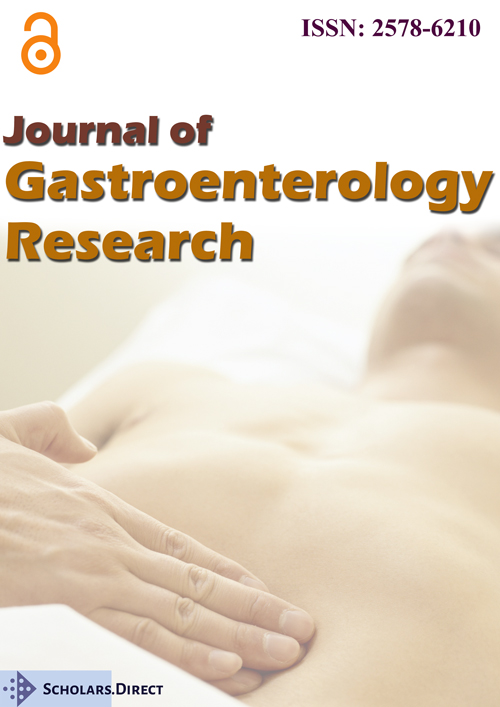Primary and Secondary Factors in Hypertriglyceridemia Induced Acute Pancreatitis: A Case-Based Focus Review
Abstract
Hypertriglyceridemia (HTG) is a known cause of pancreatitis. We described a case of severe hypertriglyceridemia (likely familial) causing the first episode of pancreatitis in this patient. A 21-year-old female known for hypertriglyceridemia and DM type 2 came to the emergency room with severe epigastric pain along with nausea and vomiting. Physical exam revealed epigastric tenderness, diminished bowel sounds, and signs of dehydration. Initial blood work was mostly unremarkable, except mildly elevated lipase 83. CT scan abdomen pelvis showed signs of peripancreatic inflammation. Additional workup revealed triglycerides > 5000 mg/dl. Diagnosis of hypertriglyceridemia-induced pancreatitis (HTGP) was made. The patient was treated with aggressive isotonic fluids, analgesics, and intravenous insulin therapy. This case highlights the presence of multiple secondary risk factors leading to severe HTG and HTGP in patients with the primary (genetic) predisposition. Incidence, pathophysiology, and management of HTGP will also be reviewed.
Keywords
Hypertriglyceridemia, Acute pancreatitis, Diabetes
Introduction
Acute pancreatitis has been reported to be 3rd most common gastrointestinal cause of hospitalization in the US after gastrointestinal haemorrhage and gallbladder diseases [1]. There are several possible etiologies of acute pancreatitis, gall stone and alcohol use being most frequent and account for about two-thirds of the total acute pancreatitis cases. Hypertriglyceridemia can account for up to 15% of acute pancreatitis cases [2]. Pancreatitis secondary to HTG is typically seen in presence of one or more secondary factors (uncontrolled DM, alcoholism, medications, pregnancy) in a patient with an underlying common genetic abnormality of lipoprotein metabolism (familial combined hyperlipidemia or familial HTG). The risk of acute pancreatitis in patients with serum triglycerides > 1000 mg/dl and > 2000 mg/dl is ∼5% and 10-20% respectively [3]. Early recognition and adequate therapy for HTG can help prevent episodes of HTG induced pancreatitis. Patient education and prevention of secondary risk factors can help minimize the risk of HTG induced pancreatitis.
In this case-based approach, we discuss various primary and secondary causes of HTG, the proposed underlying mechanism causing pancreatitis, and available treatment modalities for HTG induced pancreatitis. A brief overview of the management of hypertriglyceridemia and prevention of HTGP will also be discussed.
Case Report
21-year-old female who came to the emergency room with significant epigastric pain, nausea, and vomiting that has been going on for two days. Her past medical history is significant for hypertriglyceridemia, diabetes mellitus type 2, and mood disorders. No reported history of alcohol consumption or smoking. Her medication list included bupropion, buspiron, escitalopram, ezetimibe, simvastatin, metformin, ethinyl estradiol/norgestimate at the time of arrival to the hospital. She has been followed by an endocrinologist for a known diagnosis of hypertriglyceridemia. Her family history is unknown as she was adopted. She denied any previous episodes of pancreatitis. The patient also reported that she had a "rich dinner" about two nights ago. She reported no restriction on daily dietary intake for fat or carbohydrates.
On examination, she is in mild distress, severely tender in the epigastric region, oral mucosa dry, tachycardia, and diminished bowel sounds. Initial workup showed lipase to 83 (upper normal limit of lipase is 82), amylase normal at 46; normal AST, ALT, and alkaline phosphatise. Other significant findings included serum glucose 197 and sodium 133. Rest metabolic panel was within the normal limit. Normal WBC, mild anaemia with low MCV was noted. Additional workup showed Triglycerides > 5000 and Hb A1C 9.0.
CT scan abdomen and pelvis with contrast on arrival showed inflammatory changes in the pancreatic duodenal groove, fluid tracking along with the duodenum, and retro peritoneum to the right pericolic gutter. Unremarkable pancreases. Appearance favours acute pancreatitis. Unremarkable right upper quadrant ultrasound.
On an old record review, it was noted that her triglycerides levels were ranging from 108 mg/dl (year 2011) to 1100 mg/dl (year 2017) during the last 10 years with her last known triglyceride level was 453 mg/dl about 60 days prior to presentation to the emergency room.
A diagnosis of triglyceride-induced pancreatitis was made. Most likely familial hypertriglyceridemia triggered by uncontrolled diabetes, use of oral ethinyl estradiol, and unrestricted diet. The patient was treated for pancreatitis with isotonic intravenous fluids, hydromorphone PCA for pain control, and pancreatic rest. She was started on 0.01 u/kg/hour intravenous insulin infusion for hypertriglyceridemia. D5 and D10 were added to prevent hypoglycaemia. Triglycerides were monitored every 12 hours. After 4 days of insulin infusion, her triglycerides level was < 500 mg/dl. At this time insulin infusion along with supplemental dextrose fluids were discontinued and subcutaneous insulin glargine was initiated. Same time her abdominal pain much improved and the patient was gradually started on the diet. On day 7 of hospitalization, she was released for home. Her discharge medication included low-dose insulin glargine, atorvastatin, and fenofibrate. She was educated about limiting dietary fat to 10-15% of the total daily intake of calories and also educated about restricting concentrated carbs. She was advised to use alternative methods for birth control and avoid oral ethinyl estradiol therapy. Her triglyceride level was down to 281 mg/dl before discharge.
Discussion
Epidemiology
Hypertriglyceridemia can account for up to 15% of total acute pancreatitis cases [2]. Pancreatitis secondary to HTG is typically seen in presence of one or more secondary factors (uncontrolled diabetes, alcoholism, medications, pregnancy) in a patient with an underlying common genetic abnormality of lipoprotein metabolism (familial combined hyperlipidemia or familial HTG). See Table 1 for causes of hypertriglyceridemia. The risk of acute pancreatitis in patients with serum triglycerides > 1000 mg/dl and > 2000 mg/dl is ∼5% and 10-20% respectively [3].
In the national health and nutrition examination survey study, approximately 1.7% of the sample had severe HTG (TG 500-2000 mg/dl). Its demographic distribution was men (75.3%), non-Hispanic whites (70.1%), and aged 40 to 59 years (58.5%). See Table 2 for the classification of HTG provided by National Cholesterol Education Program Adult Treatment Panel (NCEP ATP) II and Endocrine society. The prevalence of diabetes in the US with people with severe HTG mg/dl was 14.6%, making diabetes the most common second factor associated with HTG induced pancreatitis [4]. Serum lipid levels in patients with acute pancreatitis and HTG decreased markedly during the first 72 hours of onset but remained slightly above the upper normal limit in most of them after 15 days [5]. Triglycerides levels further decline with fasting and administration of no-calorie fluids, therefore triglycerides levels should be checked in the first 24 hours of presentation or as close to the onset of symptoms. Delayed presentation or delayed testing can lead to a false conclusion about the etiology of pancreatitis. Two very small studies have shown that diagnosis of acute pancreatitis can be masked by hyperlipidemia as hyperlipidemia can interfere with assay of serum lipase and amylase activity (as seen in this case), although more data is needed to confirm this phenomenon [6,7].
Pathogenesis of HTG induced pancreatitis
The exact mechanism of HTG induced pancreatitis still remains unclear. A few studies on animal models have suggested various theories. Most acceptable theories include a) Excess of triglycerides is hydrolyzed by pancreatic lipase with local release of large quantities of free fatty acids. These free fatty and triglycerides can cause various degrees of injury to the pancreas [8,9]. b) Chylomicron-induced hyper viscosity leads to impairment in pancreatic microcirculation resulting in ischemic injury [10]. c) Hypertriglyceridemia aggravates endoplasmic reticulum stress and can lead to acute pancreatitis [11].
Risk factors
In most patients with HTG, primary (genetic) and secondary (acquired) conditions coexist [12]. Over production of VLDL by the liver leads to moderate HTG and overproduction of lipoprotein by both liver (VLDL) and intestine (Chylomicron) leads to server HTG. Common secondary factors include insulin resistance, obesity, metabolic syndrome, diabetes mellitus type 2, and hypothyroidism [13-15]. Other secondary factors are excess dietary intake of high saturated fat, high caloric food with a high glycemic index, and excess alcohol use. The use of oral estrogen replacement therapy and estrogen receptor modulators has been shown to be associated with hypertriglyceridemia and HTGP [16, 17]. Postmenopausal women who developed hypertriglyceridemia on oral estrogen-progestin therapy may benefit by switching to transdermal estradiol therapy [18].
Management
Initial diagnostic and therapeutic recommendations for HTG induced pancreatitis are the same as for any other causes of pancreatitis. Pancreatic rest, aggressive isotonic intravenous fluids, analgesics. Early determination of serum triglyceride levels is critical as triglycerides level falls quickly after a period of fasting. Obtaining serum triglyceride levels as soon as symptoms onset or within 24 hours would increase the probability of correct diagnosis [5]. Since most HTG induced pancreatitis patients have a secondary cause for HTG (like diabetes mellitus, hypothyroidism, pregnancy, use of medication like oral estrogen replacement therapies) early identification of these risk factors during the initial assessment and workup is imperative. No difference in overall severity and complication of pancreatitis has been shown in patients with HTG compared to patients without HTG [19,20].
Several therapies have been shown benefits for the treatment of HTG induced pancreatitis for rapid reduction of triglyceride level in the blood and ongoing control of HTG for future prevention of HTG induced complications [21].
Insulin therapy
Many studies and case reports have demonstrated the benefits of insulin therapy in the management of HTG induced pancreatitis. Thuzar, et al. review showed 10 cases of extreme hypertriglyceridemia (8982 ± 2070 mg/dL), a combination of fasting and intravenous insulin to be an effective and safe method for management of extreme hypertriglyceridemia [22]. Several other case reports have shown the benefit of continuous intravenous insulin (0.05-2 U/kg/h) administration until triglycerides level reached 400-1000 mg/dl and the average time to achieve the goal was about 4 days [23-25]. This has been very consistent with what was seen in the case described above. A case report shows that a single dose of regular insulin (0.1 unit/kg, subcutaneous) can help with an immediate reduction in triglyceride levels [26].
Insulin therapy has been considered helpful as, insulin (a) Inhibits lipolysis in adipose tissue and hence decreases plasm free fatty acid level, (b) Stimulates fatty acid and triglyceride synthesis in tissues, (c) Increase uptake of triglyceride from the blood into adipose tissue and muscles, (d) Decreases the rate of fatty acid oxidation in muscle and liver [27].
Apheresis for treatment of HTG induced acute pancreatitis
Most data available for this therapy is based on case reports and case series. There are no controlled studies so far to determine the eligible patient population for Apheresis and its benefits in HTG induced pancreatitis. A recent systemic review of literature done by Click, et al. provides an opinion that candidates for Apheresis therapy would be predicted server or very server Acute Pancreatitis based on revised Atlanta classification [28] with severe (≥ 1000 mg/dl) or very severe (≥ 2000 mg/dl) HTG who continue to have elevated serum TG after appropriate resuscitation with intravenous fluids and support for organ failure. Apheresis has shown some form of improvement in clinical condition in nearly all (93%) patients with server acute pancreatitis. After one or two Apheresis sessions triglycerides were reduced by 60-80% [29]. Other limitations for use of Apheresis included limited resources especially in community hospitals and delay in starting the therapy. In case reports Apheresis has shown beneficial in severe HTG with or without pancreatitis in pregnancy [30]. Bi-TPAI trial by Song, et al. is underway to compare intensive insulin therapy versus plasmapheresis in the management of HTG induced pancreatitis [31]. ELEFANT trial is an open-label multicenter, an adaptive randomized clinical trial that will be testing if early removal of triglycerides and free fatty acids from the bloodstream is beneficial in HTG induced pancreatitis (enrolment period February 2020 - December 2025) [32].
Case reports are shown the benefits of regular plasmapheresis to prevent recurrent HTG induced pancreatitis in cases of severe primary hypertriglyceridemia (type1 and V) where diet and drug therapy were insufficient [33]. Similarly, in the case of familial chylomicronemia where management of hypertriglyceridemia is challenging with diet and drug intervention, therapeutic plasma exchange has shown benefit in the treatment and prevention of HTG induced acute pancreatitis [34].
Prevention
Since most of these patients have a primary (genetic) predisposition and a secondary factor to trigger HTG induced pancreatitis, they are at risk of recurrent acute pancreatitis. Interventions to prevent recurrence should go on post-hospitalization and treatment of acute pancreatitis episodes. Early identification and aggressive treatment of diabetes mellitus, hypothyroidism, limiting alcohol consumption, and discontinuation of oral estrogen replacement therapy and estrogen receptor modulator such as tamoxifen/raloxifene.
Prevention also includes lifestyle changes to control body weight, regular aerobic activity, avoidance of concentrated carbohydrates, and in cases of severe hypertriglyceridemia restriction fat intake to 15% of total energy intake [35].
This should be followed by the addition of lipid-lowering drugs if goals are not achieved. The endocrine society recommends fibrates as a first-line for triglyceride reduction in patients with HTG induced pancreatitis and also recommends the use of any of three drugs (fibrates, niacin, and n-3 fatty acids) alone or in combination with a statin in patients with moderate to severe hypertriglyceridemia. Statin therapy should not be used alone in case of server hypertriglyceridemia [36]. Recent evidence is shown by ANCHOR (NCT01047501) study that icosapent ethyl (a high-purity form of eicosapentaenoic acid) 4 g/day can significantly improve triglycerides without worsening glycemic control in patients with diabetes [37]. A case study showed the benefit of icosapent ethyl in acute severe pancreatitis case, which is thought to be due to the anti-inflammatory benefit of the drug [38].
Conclusion
This case again proved that HTG induced pancreatitis patients have a genetic (primary) predisposition and a secondary factor to trigger these episodes. Hypertriglyceridemia noted at an early age, uncontrolled diabetes, no restriction in the diet, and oral estradiol therapy resulted in HTG induced pancreatitis. Early recognition and appropriate therapy are keystones in preventing complications. Insulin therapy, low caloric diet, and plasmapheresis are available therapies at this time. There are not enough randomized controlled trials to show the statistically significant benefit of insulin therapy and plasmapheresis. Various known modalities of treatment are available to control hypertriglyceridemia including dietary restrictions, fibrates, stating, niacin, Omega 3 fatty acid, and its derivates. Management of secondary risk factors can play a significant role in preventing HTG induced pancreatitis.
Declaration of Conflict of Interests
The author declared no potential conflicts of interest with respect to the research, authorship and/or publication of this article.
Funding
The author received no financial support for the research, authorship, and/or publication of this article.
Ethics Approval
Ethical approval to the report this case was obtained from Institutional Review Board.
Informed Consent
Verbal informed consent was obtained from the patient for their anonymized information to be published in this article.
References
- Peery AF, Crockett SD, Murphy CC, et al. (2019) Burden and cost of gastrointestinal, liver, and pancreatic diseases in the united states: Update 2018. Gastroenterology 156: 254-272.
- Zhu Y, Pan X, Zeng H, et al. (2017) A study on the etiology, severity, and mortality of 3260 patients with acute pancreatitis according to the revised atlanta classification in jiangxi, china over an 8-year period. Pancreas 46: 504-509.
- Scherer J, Singh V, Pitchumoni CS, et al. (2014) Issues in hypertriglyceridemia pancreatitis: An update. J Clin Gastroenterol 48: 195-203.
- Christian JB, Bourgeois N, Snipes R, et al. (2011) Prevalence of severe (500 to 2,000 mg/dl) hypertriglyceridemia in United States adults. Am J Cardiol 107: 891-897.
- Dominguez-Munoz JE, Malfertheiner P, Ditschuneit HH, et al. (1991) Hyperlipidemia in acute pancreatitis. Relationship with etiology, onset, and severity of the disease. Int J Pancreatol 10: 261-267.
- Warshaw AL, Bellini CA, Lesser PB (1975) Inhibition of serum and urine amylase activity in pancreatitis with hyperlipemia. Ann Surg 182: 72-75.
- Lesser PB, Warshaw AL (1975) Diagnosis of pancreatitis masked by hyperlipemia. Ann Intern Med 82: 795-798.
- Kimura W, Mossner J (1996) Role of hypertriglyceridemia in the pathogenesis of experimental acute pancreatitis in rats. Int J Pancreatol 20: 177-184.
- Saharia P, Margolis S, Zuidema GD, et al. (1977) Acute pancreatitis with hyperlipemia: Studies with an isolated perfused canine pancreas. Surgery 82: 60-67.
- Cuthbertson CM, Christophi C (2006) Disturbances of the microcirculation in acute pancreatitis. Br J Surg 93: 518-530.
- Zeng Y, Wang X, Zhang W, et al. (2012) Hypertriglyceridemia aggravates ER stress and pathogenesis of acute pancreatitis. Hepatogastroenterology 59: 2318-2326.
- Hegele RA, Ginsberg HN, Chapman MJ, et al. (2014) The polygenic nature of hypertriglyceridemia: Implications for definition, diagnosis, and management. Lancet Diabetes Endocrinol 2: 655-666.
- Laws A, Stefanick ML, Reaven GM (1989) Insulin resistance and hypertriglyceridemia in nondiabetic relatives of patients with noninsulin-dependent diabetes mellitus. J Clin Endocrinol Metab 69: 343-347.
- Bjornstad P, Eckel RH (2018) Pathogenesis of lipid disorders in insulin resistance: A brief review. Curr Diab Rep 18: 127.
- Hermans MP, Valensi P (2018) Elevated triglycerides and low high-density lipoprotein cholesterol level as marker of very high risk in type 2 diabetes. Curr Opin Endocrinol Diabetes Obes 25: 118-129.
- Jee L, Goldberg IJ (2008) "Hypertriglyceridemia-induced pancreatitis created by oral estrogen and in vitro fertilization ovulation induction." J Clin Lipidol 2: 63-66.
- Glueck CJ, Lang J, Hamer T, et al. (1994) Severe hypertriglyceridemia and pancreatitis when estrogen replacement therapy is given to hypertriglyceridemic women. J Lab Clin Med 123: 59-64.
- Sanada M, Tsuda M, Kodama I, et al. (2004) Substitution of transdermal estradiol during oral estrogen-progestin therapy in postmenopausal women: Effects on hypertriglyceridemia. Menopause 11: 331-336.
- Balachandra S, Virlos IT, King NK, et al. (2006) Hyperlipidaemia and outcome in acute pancreatitis. Int J Clin Pract 60: 156-159.
- Kim SJ, Kang H, Kim EJ, et al. (2020) Clinical features and outcomes of hypertriglyceridemia-induced acute pancreatitis: Propensity score matching analysis from a prospective acute pancreatitis registry. Pancreatology 20: 617-621.
- Ewald N, Hardt PD, Kloer HU (2009) Severe hypertriglyceridemia and pancreatitis: Presentation and management. Curr Opin Lipidol 20: 497-504.
- Thuzar M, Shenoy VV, Malabu UH, et al. (2014) Extreme hypertriglyceridemia managed with insulin. J Clin Lipidol 8: 630-634.
- Tamez-Perez HE, Saenz-Gallegos R, Hernandez-Rodriguez K, et al. (2006) Insulin therapy in patients with severe hypertriglyceridemia. Rev Med Inst Mex Seguro Soc 44: 235-237.
- Sawalha K, Kunnumpurath A, Kamoga GR (2020) The efficacy of intravenous insulin infusion in the management of hypertriglyceridemia-induced pancreatitis in a rural community hospital. J Investig Med High Impact Case Rep 8: 2324709620940492.
- Maric N, Mackovic M, Bakula M, et al. (2022) Hypertriglyceridemia-induced pancreatitis treated with continuous insulin infusion-case series. Clin Endocrinol (Oxf) 96: 139-143.
- Jabbar MA, Zuhri-Yafi MI, Larrea J (1998) Insulin therapy for a non-diabetic patient with severe hypertriglyceridemia. J Am Coll Nutr 17: 458-461.
- Dimitriadis G, Mitrou P, Lambadiari V, et al. (2011) Insulin effects in muscle and adipose tissue. Diabetes Res Clin Pract 1: S52-S59.
- Banks PA, Bollen TL, Dervenis C, et al. (2013) Classification of acute pancreatitis--2012: Revision of the atlanta classification and definitions by international consensus. Gut 62: 102-111.
- Click B, Ketchum AM, Turner R, et al. (2015) The role of apheresis in hypertriglyceridemia-induced acute pancreatitis: A systematic review. Pancreatology 15: 313-320.
- Basar R, Uzum AK, Canbaz B, et al. (2013) Therapeutic apheresis for severe hypertriglyceridemia in pregnancy. Arch Gynecol Obstet 287: 839-843.
- Song X, Shi D, Cui Q, et al. (2019) Intensive insulin therapy versus plasmapheresis in the management of hypertriglyceridemia-induced acute pancreatitis (Bi-TPAI trial): Study protocol for a randomized controlled trial. Trials 20: 365.
- Zadori N, Gede N, Antal J, et al. (2020) Early elimination of fatty acids in hypertriglyceridemia-induced acute pancreatitis (elefant trial): Protocol of an open-label, multicenter, adaptive randomized clinical trial. Pancreatology 20: 369-376.
- Piolot A, Nadler F, Cavallero E, et al. (1996) Prevention of recurrent acute pancreatitis in patients with severe hypertriglyceridemia: Value of regular plasmapheresis. Pancreas 13: 96-99.
- Fitts E, Lee PDK, Yates SG (2019) Efficacy of therapeutic plasma exchange in reducing the incidence of recurrent pancreatitis related to familial chylomicronemia. Transfusion 59: 3324-3328.
- Ohni M (2013) Lifestyle modifications for treatment of hypertriglyceridemia. Nihon Rinsho 71: 1630-1635.
- Berglund L, Brunzell JD, Goldberg AC, et al. (2012) Evaluation and treatment of hypertriglyceridemia: An endocrine society clinical practice guideline. J Clin Endocrinol Metab 97: 2969-2989.
- Brinton EA, Ballantyne CM, Bays HE, et al. (2013) Effects of icosapent ethyl on lipid and inflammatory parameters in patients with diabetes mellitus-2, residual elevated triglycerides (200-500 mg/dL), and on statin therapy at LDL-C goal: The Anchor study. Cardiovasc Diabetol 12: 100.
- Berger AA, Sherburne R, Urits I, et al. (2020) Icosapent ethyl (Vascepa®) for the treatment of acute, severe pancreatitis. Cureus 12: e11551.
Corresponding Author
Pankaj Agrawal MD, Department of Medicine, South Georgia Medical Centre, Valdosta, GA, USA.
Copyright
© 2022 Agrawal P. This is an open-access article distributed under the terms of the Creative Commons Attribution License, which permits unrestricted use, distribution, and reproduction in any medium, provided the original author and source are credited.




